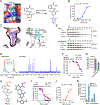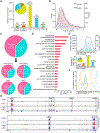Small-Molecule Targeting of Oncogenic FTO Demethylase in Acute Myeloid Leukemia
- PMID: 30991027
- PMCID: PMC6812656
- DOI: 10.1016/j.ccell.2019.03.006
Small-Molecule Targeting of Oncogenic FTO Demethylase in Acute Myeloid Leukemia
Abstract
FTO, an mRNA N6-methyladenosine (m6A) demethylase, was reported to promote leukemogenesis. Using structure-based rational design, we have developed two promising FTO inhibitors, namely FB23 and FB23-2, which directly bind to FTO and selectively inhibit FTO's m6A demethylase activity. Mimicking FTO depletion, FB23-2 dramatically suppresses proliferation and promotes the differentiation/apoptosis of human acute myeloid leukemia (AML) cell line cells and primary blast AML cells in vitro. Moreover, FB23-2 significantly inhibits the progression of human AML cell lines and primary cells in xeno-transplanted mice. Collectively, our data suggest that FTO is a druggable target and that targeting FTO by small-molecule inhibitors holds potential to treat AML.
Keywords: FTO inhibitor; RNA epitranscriptomics; acute myeloid leukemia; cancer therapy; structure-based design; target validation.
Copyright © 2019 Elsevier Inc. All rights reserved.
Figures








Comment in
-
The Yin and Yang of RNA Methylation: An Imbalance of Erasers Enhances Sensitivity to FTO Demethylase Small-Molecule Targeting in Leukemia Stem Cells.Cancer Cell. 2019 Apr 15;35(4):540-541. doi: 10.1016/j.ccell.2019.03.011. Cancer Cell. 2019. PMID: 30991023
References
-
- Aik W, Demetriades M, Hamdan MK, Bagg EA, Yeoh KK, Lejeune C, Zhang Z, McDonough MA, and Schofield CJ (2013). Structural basis for inhibition of the fat mass and obesity associated protein (FTO). J. Med. Chem 56, 3680–3688. - PubMed
-
- Akichika S, Hirano S, Shichino Y, Suzuki T, Nishimasu H, Ishitani R, Sugita A, Hirose Y, Iwasaki S, Nureki O, and Suzuki T (2019). Cap-specific terminal N (6)-methylation of RNA by an RNA polymerase II-associated methyltransferase. Science 363. - PubMed
Publication types
MeSH terms
Substances
Grants and funding
LinkOut - more resources
Full Text Sources
Other Literature Sources
Molecular Biology Databases
Research Materials

